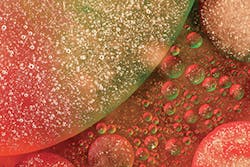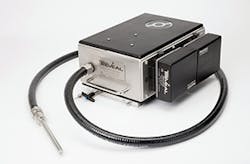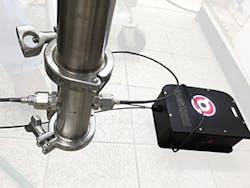Technical Focus: Fully Rinsed? Spectroscopy Provides Answers
In order to avoid unnecessary shutdowns and the high costs associated with them, manufacturing systems need to be flushed at regular intervals. The practice is a high-value maintenance practice that is required throughout the industrial world. Returning a system to its original cleanliness level will not only allow it to operate more efficiently, but will inherently add several years of life to the equipment. When conducting a flush, operators can now use in situ spectroscopy as a process measurement technology in order to determine when the job is complete, preventing excess wastewater.
Flushing Standards
The regularity of the flushing will depend on the individual machine and its specific requirements, but most manufacturing lines and systems will need some kind of rinsing or flushing. There are many situations in which flushing is warranted. These conditions include when new machines are commissioned, when filters fail and release contaminants into the system, when broken components result in the release of particulate matter in the system, or when a machine has simply been idle for too long. In any of these situations, it is likely that a flushing or rinsing of the line will need to occur. When a change of materials manufactured in batches is going to take place, there is typically a chemical rinse and then a water flushing of the systems involved to prevent polluting or cross-contaminating the next batch of material. Anytime there is an oil change in the system, a flush will generally need to be done. When supplying a system with fresh oil, the operator wants to know that the system is completely free of degraded oil and particulates. Additionally, when there is an indication of sludge or varnish, machines should be flushed. One of the critical issues, especially in places like California, is conserving the amount of water used in the process of flushing a system. Operators need to know that their system is fully flushed, but doing so efficiently with minimal water use can be a challenge. While standards have been set on best practices in flushing systems, there has not been as much attention paid to conserving water during these practices.
Water Reduction Mandate
California Governor Jerry Brown directed the State Water Board to implement mandatory water reductions in urban areas to reduce potable urban water usage by 25%. On May 5, 2015, the State Water Board adopted an emergency conservation regulation in accordance with the Governor’s directive, and the provisions went into effect on May 18, 2015. During these times of high alert in water conservation, new tools are being developed in order to help provide a solution.
A machine operator’s primary concern is that the system gets completely flushed, not about how much water is used or how efficiently they have completed a flush. Most operators will approach the practice from the standpoint of making sure that all the chemicals and solvents that need to be rinsed away are completely flushed from the system. The issue with this comes during times of water shortages much like what is being seen in California. It can sometimes be difficult to thinkabout how much excess water is utilized in the flushing and rinsing practice of manufacturing lines during times of shortages or droughts. Operators are always going to play it safe. The solution, then, is to let the operators know when their system is completely flushed without having to use more water than they need to. For years, operators have wished for a system that would give them access to a real-time display of when the levels of solvents, chemicals, or other materials are where they need to be or fully washed away. Now, there is a measuring science that provides operators with this information immediately: spectroscopy.
The Reveal UV process analyzer for cleaning validation
What Is Spectroscopy?
Spectroscopy is a mature measuring science; however, there are new devices taking advantage of it. Spectroscopy studies the interaction between matter and radiated energy and can be performed using any portion of the electromagnetic spectrum. In the case of measuring something like chemicals or solvents in a system, spectroscopy involves the portion from the ultraviolet through infrared, which is generically referred to as “light.”
This means that spectroscopy is used in this respect by illuminating the sample stream with a known range of light and then meticulously analyzing the reflected or absorbed light to extract chemical information about the sample. Different substances will interact with light in different ways. This is the basic principle that makes spectroscopy work. Someone can now detect the proverbial “needle in the haystack,” and additionally, find the size and number of needles in that given “haystack.” It can get complicated, but the most appealing element of this measuring science is that, unlike the recent past in which samples had to be drawn out of the production lines, taken to a lab, and move through a queue to learn the status of what is passing through the lines, this can now all happen in real time.
Spectroscopy systems are currently available that can be installed directly on or in the production lines, giving operators and their management teams point-of-use data in millisecond time frames. Additionally, there are systems that offer a closed-loop feedback capability where the systems can be linked to allow changes to be made based on what the spectrometer identifies passing through the lines. This can make a huge difference in both waste reduction for out-of-specification product and in preventing the over-rinsing of systems that are cleared of what needed to be purged.
The four main wavelength regions of light typically used in spectroscopy-based process measurement are ultraviolet (UV), visible, near-infrared, and infrared. In the case of measuring systems for chemicals and solvents, the UV variety of spectroscopy is what is typically used. This type of spectroscopy is best suited for the measurement of very low concentrations of a target molecule in a liquid stream. Obtaining this optical sign from the sample is only half of the solution.
An in-line real-time process analyzer platform
The other half involves converting that optical information into something useful which entails a combination of signal processing and statistics and is its own science known as chemometrics. Improvements in this field now allow you to obtain detailed information about processes that was not available in the past. The technology now provides chemical and physical information that is not only nearly instant but requires no sample preparation, won’t contaminate your system, and doesn’t produce waste or take any consumables to accomplish its task. Additionally, due to the convenient way that operators can now access this science, it does not require trained spectroscopists or scientists to analyze the data. There are affordable, easily accessible, point-of-use units to fit nearly any application in manufacturing available today.
Spectroscopy and Water Conservation Devices are being packaged now that can deliver this science at a relatively low cost. This is why there has been an uptick in interest regarding spectroscopy and the solutions that it can now deliver on the manufacturing floor. It used to require highly trained engineers and scientists to analyze such complex information and operate such complicated machinery in a lab to obtain this level of information. Now, with the simple, user-friendly devices that are available on the market, morespectroscopic solutions are being discovered. When a spectroscopic device can accurately read the chemical makeup of a liquid nearly instantly, and deliver the report in a way that any machine operator can interpret the results, there is real potential for environmental (and production) benefits to be realized. Users are able to monitor the analyzer, stream real-time data, log operator and production activity, and monitor output from anywhere they wish, both inside the plant and time zones away. The use of this improved technology is a game-changer both for maintaining the integrity of manufacturing systems and preserving the largest possible amount of water while doing so. It is like having an immediate view into what is flowing in your lines at all times.


